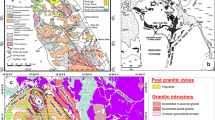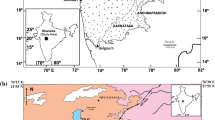Abstract
Rhyolite domes formed over a million year continuum in eastern California are used to study boulder dominated slopes. Slopes in this study are steep (∼25° to ∼35°) and are made of coarse boulder sized blocks. These slopes include well varnished vertically oriented colluvial deposits that have been likened to relict periglacial stone stripes, or as indicated in this study, are the result of ongoing desert slope processes. The deposits are common throughout the arid southwestern US, but their morphometric character, fabric, and rates of formation have not been assessed systematically. Results indicate that boulder deposits examined here are remnant from the original surface formed during volcanic eruption and that these boulder slope deposits evolve slowly. Grain size, grain shape and grain angularity do not change significantly from genesis to ∼0.6 Ma; trends in the data change markedly after that time. Mean eigenvectors indicate a fabric oriented downhill, parallel to the slope, consistent with the visual impression that long thin to plate-like rocks orient themselves similarly; however, fabric is actually randomly dispersed, similar to that at slope genesis, as indicated by the eigenvalue analysis resultants ofC andK. Interestingly, grains remain or become more angular over the million-year time scale of the study as they decrease in size, indicating active in situ weathering processes on individual grains; this result is counter to the common assumption that as grains weather they become more rounded over time.
Similar content being viewed by others
References
Andrews, J. T. 1971a. Methods in the Analysis of Till Fabrics. In: Goldthwait, R. P. (ed.),Till a Symposium. Ohio State University Press. Pp. 321–327.
Andrews, J. T. 1971b. Techniques of Till Fabric Analysis.British Geomorphological Research Group, Technical Bulletin, #6.
Andrews, J. T. &IngleSmith, D. 1966. The Variability of Till Fabric.British Geomorphological Group, Occasional Paper 3: 33–37.
Andrews, J. T. &Shimizu, K. 1966. Three-dimensional Vector Technique for Analyzing Till Fabrics: Discussion and FORTRAN Program.Geographical Bulletin 8(2): 151–165.
Blackwelder, E. 1934. Talus Slopes in the Basin Range Province. In:Geological Society of America Annual Meeting, Vol. Proceedings, Pp. 317.
Bloom, A. L. 1978.Geomorphology. Prentice-Hall, Inc., Englewood Cliffs, New Jersey, Pp. 510.
Bryan, K. 1922. Erosion and Sedimentation in the Papago Country, Arizona.United States Geological Survey Bulletin,730-B: 19–90.
Caine, T. N. 1963. The Origin of Sorted Stripes in the Lake District, Northern England.Geografiska Annaler 45(2–3): 172–179.
Caine, T. N. 1968a.The Blockfields of Northern Tasmania. Australian National University, Canberra, Pp. 127.
Caine, T. N. 1972. Air Photo Analysis of Blockfield Fabrics in Talus Valley, Tasmania.Journal of Sedimentary Petrology,42(1): 33–48.
Caine, T. N. 1983.The Mountains of Northeastern Tasmania. A. A. Balkema, Rotterdam. Pp. 200.
Caine, T. N. &Jennings, J. N. 1968. Some Blockstreams of the Toolong Range Kosciusko State Park, New South Wales.Journal and Proceedings, Royal Society of New South Wales 101: 93–103.
Cheeney, R. F. 1983.Statistical Methods in Geology for Field and Lab Decisions. George Allen & Unwin, London, Pp. 169.
Cluer, J. K. 1988. Leveed Boulder Flows on Volcanic Slopes of the Sonoran Desert, Arizona.Journal of Arid Environments 15: 43–52.
Compton, R. R. 1962.Manual of Field Geology. John Wiley & Sons, Inc., New York, Pp. 378.
Davis, J. C. 1986.Statistics and Data Analysis in Geology. John Wiley & Sons, New York, Pp. 686.
Denny, C. S. &Drewes, H. 1965. Geology of the Ash Meadows Quadrangle Nevada-California.United States Geological Survey Bulletin 1181-L.
Dorn, R. I., Jull, A. J. T., Donahue, D. J., Linick, T. W. &Toolin, L. J. 1989. Accelerator Mass Spectrometry Radiocarbon Dating of Rock Varnish.Geological Society of America Bulletin 101: 1363–1372.
Dorn, R. I. &Krinslev, D. 1994. New Perspectives on Colluvial Boulder Deposits in the Southwestern Great Basin, USA.Physical Geography 15(1): 62–79.
Duffield, W. A. & Bacon, C. R. 1981. Geologic map of the Coso Volcanic Field and adjacent areas, Inyo County, California.United States Geological Survey Miscellaneous Investigations Series, Map I-1200.
Duffield, W. A., Bacon, C. R. &Dalrymple, G. B. 1980. Late Cenozoic Volcanism, Geochronology and Structure of the Coso Geothermal Area, Inyo County.Journal of Geophysical Research 85(B5): 2381–2404.
Fairbridge, R. W. 1968. The Encyclopedia of Geomorphology. In:Encyclopedia of Earth Sciences Series, Vol. III, Pp. 1295. Dowden, Hutchinson & Ross, Stroudsburg, Pennsylvania.
Fisher, R. A. 1953. Dispersion on a Sphere.Proceedings of the Royal Society of London, Series A 217: 295–306.
Folk, R. L. 1974.Petrology of Sedimentary Rocks. Hemphill Publishing Co., Austin, Texas. Pp. 182.
Friend, D. A. 1997. Evolution of Desert Colluvial Boulder Fields, Eastern California. Ph.D. Dissertation, Arizona State University.
Friend, D. A. 2000. Revisiting William Morris Davis and Walther Penck to Propose a General Model of Slope ‘Evolution’ in Deserts.The Professional Geographer 52(2): 164–178.
Friend, D. A.,Phillips, F. M., Campbell, S. W., Liu, T. &Sharma, P. 2000. Evolution of Desert Colluvial Boulder Slopes.Geomorphology 36(1–2): 19–45.
Harrington, C. D. & Whitney, J. D. 1991. Quaternary Erosion Rates on Hillslopes in the Yucca Mountain Region, Nevada. In:Geological Society of America Annual Meeting, Vol. 23(5), Pp. A118.Abstracts with programs.
Hicock, S. R., Goff, J. R., Lian, O. B. &Little, E. C. 1996. On the Interpretation of Subglacial Till Fabric.Journal of Sedimentary Research 66(5): 928–934.
Hu, Q.,Smith, P. E., Evensen, N. M. &York, D. 1994. Lasing in the Holocene: Extending the 40Ar-39Ar Laser Probe Method into the 14C Range.Earth and Planetary Science Letters 123: 331–336.
Kamb, W. B. 1959. Ice Petrofabric Observations from Blue Glacier. Washington, in Relation to Theory and Experiment.Journal of Geophysical Research 64(11): 1891–1909.
Lovejoy, E. M. P. 1972. Wisconsin Boulder Flow and its Geomorphic Implications, Franklin Mountains, El Paso County, Texas.Geological Society of America Bulletin 83: 3501–3508.
Macdonald, G. A. 1972.Volcanoes. Prentice-Hall, Englewood Cliffs, New Jersey, Pp. 510.
Marcus, W. A.,Ladd, S. C., Stoughton, J. A. &Stock, J. W. 1995. Pebble Counts and the Role of User-dependent Bias in Documenting Sediment Size Distributions.Water Resources Research 31(10): 2625–2631.
Mardia, K. V. 1972Statistics of Directional Data. Academic Press, New York. Pp. 357.
Mark, D. M. 1973. Analysis of Axial Orientation Data, Including Till Fabrics.Geological Society of America Bulletin 84: 1369–1374.
Marshak, S. &Mitra, G. 1988.Basic Methods of Structural Geology. Prentice Hall, Englewood Cliffs, New Jersey. Pp. 446.
Melton, M. A. 1965. Debris-covered Hillslopes of the Southern Arizona Desert-Consideration of their Stability and Sediment Contribution.Journal of Geology 73: 715–729
Millar, S. W. S. 1998. Possible Fabric Data Biasing Resulting from Sampling Methodology. In:94th Annual Meeting of the Association of American Geographers Abstracts, Pp. 552, Boston, MA.
Millar, S. W. S. &Nelson, F. E. 2001. Sampling-surface Orientation and Clast Macrofabric in Periglacial Colluvium.Earth Surface Processes and Landforms 26: 523–529
Miller, C. D. 1985. Chronology of Holocene Eruptions at the Inyo Volcanic Chain, California — Implications for possible eruptions in Long Valley Caldera.Geology 13: 14–17
Nials, F. L. & Davis, J. O. 1990. Linear, Sorted Stone Features (stone gullies) in the Great Basin are of Fluvial, not Permafrost, Origin. In:Geological Society of America Annual Meeting, Vol. 22, Pp. A109.Abstracts with programs.
Péwé, T. L. 1983. The Periglacial Environment in North America during Wisconsin time. In: Wright, H. E., Jr. (eds.),Late Quaternary Environments of the United States, Vol. 1: The Pleistocene. University of Minnesota Press, Minneapolis.Editor. Pp. 157–189.
Powers, M. C. 1953. A New Roundness Scale for Sedimentary Particles.Journal of sedimentary petrology 23(2): 117–119.
Prokopovich, N. P. 1987. Rock Stripes of the Sierra Nevada Foothills.California Geology 27–30.
Shafer, D. S. 1986. Paleoclimatic Significance of Late Wisconsin Cryogenic Deposits in the Central Great Basin, Eastern Nevada. In:American Quaternary Association ninth biennial meeting. University of Illinois, Champaign-Urbana.Program and abstracts. Pp. 163.
Sieh, K. &Bursik, M. 1986. Most Recent Eruption of the Mono Craters, Eastern Central California.Journal of Geophysical Research 91(B12): 12539–12571.
Wells, S. G.,Ford, R. L., Grimm, J. P., Martinez, G. F., Pickle, J. D., Sares, S. W. &Weadock, G. L. 1982. Development of Debris Flows on Debris-mantled Hillslopes: an Example of Feedback Mechanisms in Desert Hillslope Processes. In: Leopold, L. B. (ed.),American Geomorphological Field Group. Pp. 141, Pinedale, Wyoming.Field Trip Guidebook.
Whitney, J. S. & Harrington, C. D. 1988. Middle Pleistocene Colluvial Boulder Flows on Yucca Mountain in Southern Nevada. In:Geological Society of America Annual Meeting, Vol. 20(7), Pp. A348.Abstracts with programs.
Whitney, J. W. &Harrington, C. D. 1993. Relict Colluvial Boulder Deposits as Paleoclimatic Indicators in the Yucca Mountain Region, Southern Nevada.Geological Society of America Bulletin 105: 1008–1018.
Woodcock, N. H. 1977. Specification of Fabric Shapes Using and Eigenvalue Method.Geological Society of America Bulletin 88: 1231–1236.
Woodcock, N. H. &Naylor, M. A. 1983. Randomness Testing in Three-dimensional Orientation Data.Journal of Structural Geology 5(5): 539–548.
Author information
Authors and Affiliations
Corresponding author
Rights and permissions
About this article
Cite this article
Friend, D.A. Surface macrofabric of boulder dominated desert mountain slopes, California, USA. J. Mt. Sci. 2, 181–192 (2005). https://doi.org/10.1007/BF02973191
Received:
Accepted:
Issue Date:
DOI: https://doi.org/10.1007/BF02973191




